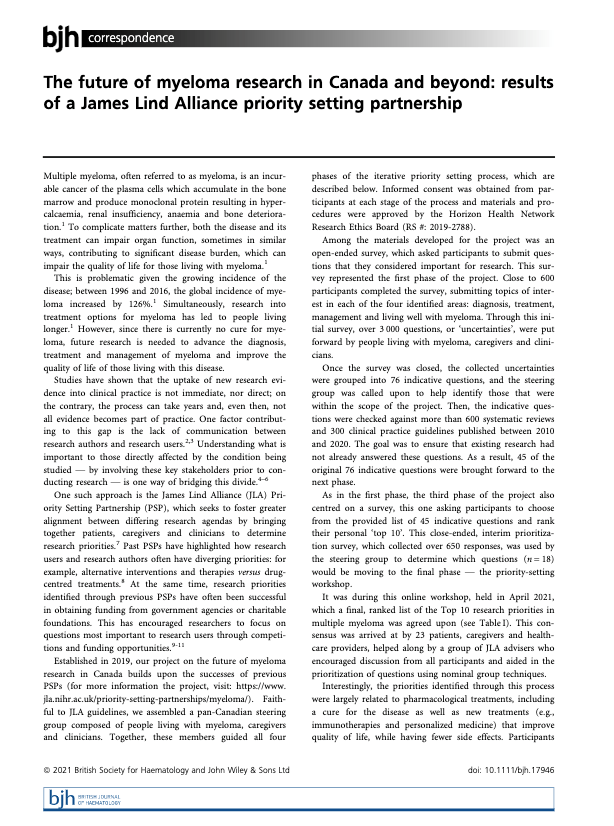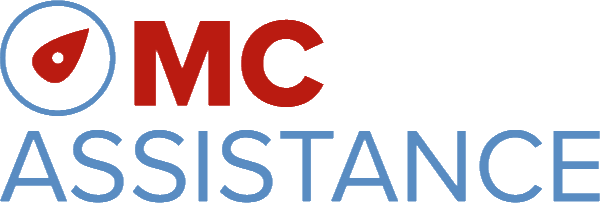Myeloma Canada’s involvement in the Myeloma PSP reflects our commitment to support research that matters most to our community members living with, or otherwise impacted by this complex disease.
PSP research priorities
Started in the fall of 2019, the Myeloma Priority Setting Partnership (PSP) was a unique project that surveyed the Canadian myeloma community to determine their top 10 priorities for future myeloma research.
A pan-Canadian committee—consisting of Canadians living with myeloma, caregivers, and healthcare professionals–worked together through the established James Lind Alliance (JLA) process to vet over 3,000 questions before arriving at the final top 10 myeloma research priorities.
There were many common themes that emerged from the bank of questions received, most of which centred around:
- improving the time and process for diagnoses;
- lifestyle;
- quality of life.
While the PSP focuses on the top 10 myeloma research priorities, we have safeguarded all questions for future consideration.

The British Society for Haematology journal published a paper that included the list of the top 10 future myeloma research questions.
The prioritized top 10 myeloma research questions identified by the Myeloma PSP
How can we cure myeloma?
Are novel immunotherapies effective for the treatment of myeloma?
How can we improve the diagnosisThe process of identifying a disease by its signs and symptoms. (i.e., faster, less invasive) of myeloma, and what is the impact of earlier diagnosis on patient outcomes?
What are new treatments for myeloma patients that will improve life expectancy with fewer adverse side effectsProblems that occur due to drugs used for disease treatment. Common side effects of cancer treatment are fatigue, nausea, vomiting, decreased blood cell counts, hair loss, and mouth sores.?
How can we personalize a patient’s treatment based on their type of myeloma and geneticInherited; having to do with information that is passed from parents to children through DNA in the genes. profile, and what is the impact of personalized medicine on treatment efficacyThe power to produce an effect; in cancer research "efficacy" refers to whether the treatment is effective. and disease outcomes?
How can we prevent bone deterioration and/or repair bones that have been damaged without negative side effects or surgery?
How can we safely reduce, cycle, or stop the use of medications to reduce the side effects of treatment and maintain control over myeloma?
How can we reduce or manage the short- and long-term effects of myeloma treatment?
What is the most effective way (i.e., drug combinations, sequence, frequency, and intensity) to treat refractoryDisease that is unresponsive to standard treatments., relapsed, and drug-resistant myeloma?
Can we develop treatments specifically for high-risk or aggressive myeloma that will improve outcomes for these patients?
What was the Myeloma Priority Setting Partnership?
The PSP was a unique project that surveyed the Canadian myeloma community to determine their top 10 priorities for future myeloma research. A pan-Canadian committee consisting of Canadians living with myeloma, caregivers, and healthcare professionals worked together through the established James Lind Alliance (JLA) process to vet over 3,000 questions before arriving at the final list. This exhaustive process included community surveys, analyses, and a consensus-building workshop.
The Myeloma PSP was supported by Myeloma Canada, and representatives and researchers at the Maritime SPOR SUPPORT Unit (MSSU). The project was spearheaded by Dr Tony Reiman, medical oncologistA doctor who specializes in treating cancer. Some oncologists specialize in a particular type of cancer treatment. at the Saint John Regional Hospital within the Horizon Health Network (New Brunswick) and Science Lead for the MSSU team (Saint John).
The Myeloma PSP was a three-phase project
In the fall of 2019 we conducted the first survey asking people living in Canada with myeloma, their caregivers, clinicians, and healthcare professionals what they felt were the most important myeloma research questions to be answered. The 1st survey was completed in January 2020 and a total of 594 patients, caregivers, and healthcare professionals submitted 3,032 questions on what they’d like to see answered on the diagnosis, treatment, management, and living well with myeloma.
All responses were anonymous and information shared was strictly confidential.
The 3,302 questions from the 1st survey were filtered down to the 45 most popular questions that fell within the scope of this initiative. In this prioritization survey, people living with myeloma, their caregivers, and healthcare professionals were asked to select their top 10 priority research questions from these 45 questions.
Once the 2nd phase survey closed, a group of researchers from Horizon Health Network in New Brunswick together with the Myeloma PSP team analyzed all responses and created a shortlist of research priorities. The short-listed topics went forward to the 3rd phase of the program, a final workshop involving people impacted by myeloma (patients, caregivers) and healthcare professionals. Together, they created the final Top 10 Myeloma Research Priority Questions.
This final list of Top 10 Myeloma Research Priority Questions is shared and promoted to encourage funders to commission researchers to answer the prioritized questions. The entire process was overseen by a UK-based, non-profit organization called the James Lind Alliance.














